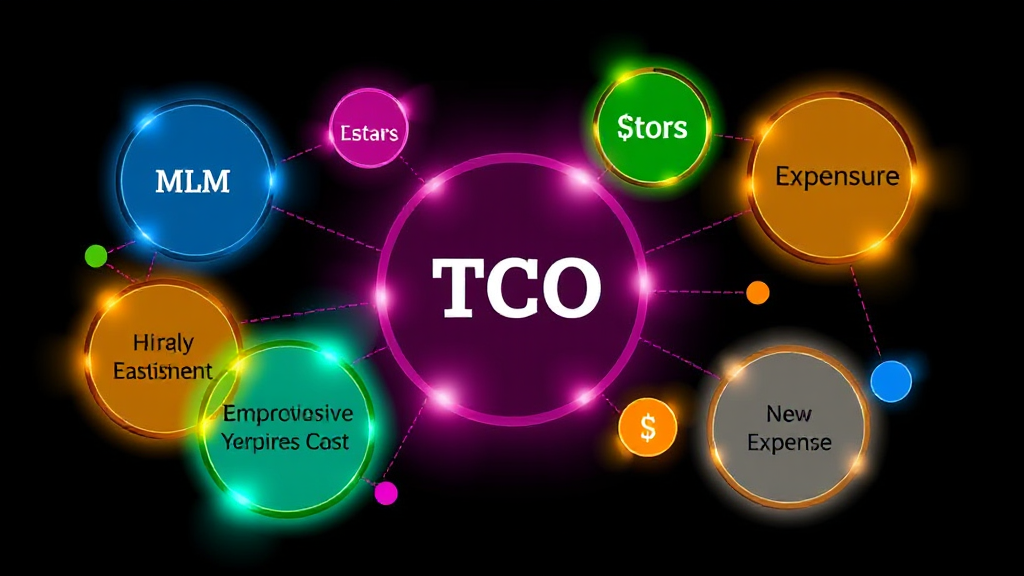Understanding the Total Cost of Ownership (TCO) for MLM Software

For a deeper dive, see our
.
This abstract design illustrates the interconnected components of TCO for MLM software, emphasizing cost efficiency and comprehensive financial analysis.
When it comes to running a multi-level marketing (MLM) business, selecting the right software powered by AI services is critical. However, what often gets overlooked is understanding the Total Cost of Ownership (TCO) associated with that software accessible via mobile platforms. Many businesses focus solely on the upfront costs, only to discover hidden expenses down the line. In this article, we'll break down everything you need to know about TCO for MLM software, including its components, how to calculate it, and why it matters for your business's long-term success.
What Is Total Cost of Ownership (TCO)?
Total Cost of Ownership (TCO) is a financial metric that calculates the total cost of acquiring and maintaining an asset over its entire lifecycle. For MLM software, TCO includes all expenses related to purchasing, implementing, maintaining, and updating the software powered by AI automation, as well as any associated hardware or training costs managed through API integration.
Understanding your TCO is essential because it allows you to make informed decisions about which software solution best aligns with your business goals and budget. It also helps you avoid surprises down the line, such as unexpected maintenance fees or scalability issues in mobile apps.
Components of TCO for MLM Software
To accurately calculate the TCO for your MLM software, you need to consider several key components:
1. Software Licensing Costs
The cost of purchasing or licensing the software is often the most significant upfront expense. Many MLM software providers offer tiered pricing plans based on the number of users or features required. Be sure to evaluate whether the licensing model suits your business’s current and future needs.
2. Subscription Fees
Some MLM software comes with a one-time purchase price, while others require monthly or annual subscriptions. Subscription-based models can add up over time, so it’s important to factor these recurring costs into your TCO calculation.
3. Hardware and Infrastructure Costs
If you’re running your MLM software on in-house servers, you’ll need to account for the cost of hardware, hosting, and IT infrastructure. Cloud-based solutions may reduce these expenses, but they still require reliable internet connectivity and data security measures.
4. Maintenance and Support Costs
Software maintenance and technical support are often included in licensing agreements, but this isn’t always the case. If these services aren’t bundled with your software, you’ll need to budget for them separately.
5. Training Costs
Onboarding your team to a new MLM software platform can be time-consuming and resource-intensive. Consider the cost of training programs, whether they’re provided by the software vendor or outsourced to third-party experts.
How to Calculate TCO for Your MLM Software
Calculating TCO involves breaking down all costs associated with acquiring and maintaining your MLM software over its lifecycle. Here’s a step-by-step approach:
Step 1: Identify All Costs
List every expense related to the software, including licensing fees, subscription costs, hardware requirements, maintenance, support, and training.
Step 2: Determine Timeframe
Consider the software’s expected lifespan. Most MLM software remains relevant for 3-5 years, but this can vary depending on industry trends and business needs.
Step 3: Calculate Total Expenses
Add up all the costs identified in Step 1 over the software’s lifecycle. This will give you your total cost of ownership.
Step 4: Compare Options
If you’re evaluating multiple MLM software options, calculate the TCO for each to determine which provides the best value for your business.
Why TCO Matters for Your MLM Business
Understanding your TCO helps you make smarter purchasing decisions and avoid financial pitfalls. For example:
-
Budgeting:
By knowing your TCO upfront, you can allocate funds appropriately in your business plan.
-
Scalability:
A software solution that’s cost-effective today may become prohibitively expensive as your business grows.
-
Long-Term Savings:
Identifying a software with low maintenance and support costs can lead to significant savings over time.
Anticipating Future Costs
In addition to calculating your current TCO, it’s important to anticipate future expenses. For instance:
-
Will you need to upgrade the software or hardware in the next few years?
-
Are there additional features or modules you’ll likely adopt?
-
How will changes in regulations or market trends impact your software needs?
By thinking ahead, you can build a more resilient budget and ensure your MLM business remains competitive.
Conclusion
Ready to take the next step?
.
While selecting the right MLM software is crucial for your business’s success, it’s equally important to understand the
Total Cost of Ownership (TCO)
associated with that software. By breaking down all related expenses and factoring in future costs, you can make informed decisions that align with your budget and long-term goals. Remember, choosing a software solution based solely on upfront costs may lead to unforeseen expenses down the line.
Take the time to evaluate your options carefully, and don’t hesitate to reach out to experts if needed. By doing so, you’ll position your MLM business for sustained growth and profitability in an increasingly competitive market.
Related Articles
Why You Need Modern MLM Software: Streamlining Your Business Operations
Streamline your MLM business with modern software! Discover how cutting-edge technology can boost efficiency, simplify operations, and drive success in today's
The Future of MLM Software: Enhancing Business Efficiency with AI-Driven Solutions
Discover how AI-driven solutions revolutionize MLM software, streamlining operations and boosting efficiency with smart contracts and seamless collaboration. Un
Scalable Gift Plan MLM Software: Revolutionizing Customer Engagement
Here's a concise and compelling SEO meta description for your blog post: Discover how scalable gift plan MLM software revolutionizes customer engagement with s